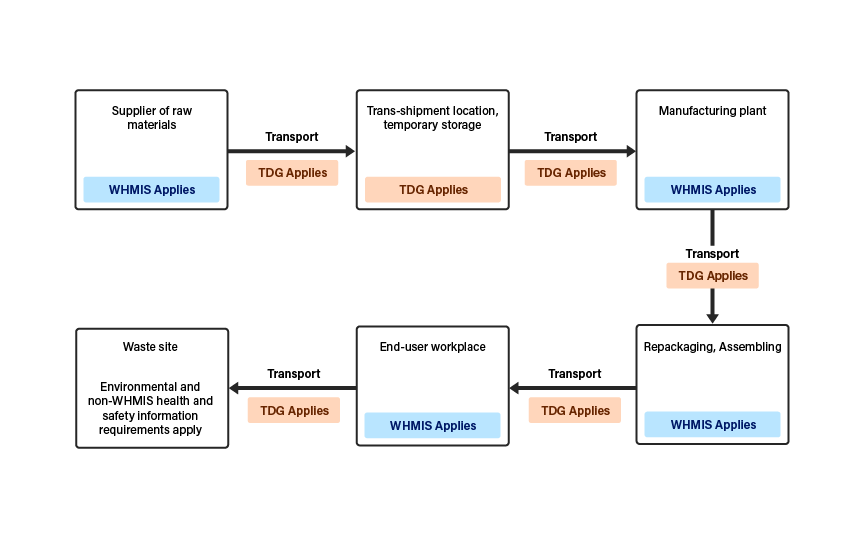Health and Safety Legislation in Canada - Handling Products: WHMIS or TDG
On this page
- What does the term “handling” mean?
- When handling a product that is classified by both WHMIS and TDG, which laws apply and when?
- What is an example of products being received and stored in a warehouse?
- When do WHMIS requirements apply?
- When do TDG requirements apply?
- Can the same product be regulated by both systems?
What does the term “handling” mean?
Back to topUnder the Transportation of Dangerous Goods Act (Canada), handling is defined as:
Handling: means loading, unloading, packing or unpacking dangerous goods in a means of containment for the purposes of, in the course of or following transportation and includes storing them in the course of transportation; (manutention)
Under the Workplace Hazardous Materials Information System (WHMIS), handling is not formally defined by the Hazardous Products Act or regulations. When legislation does not define a term, it is generally understood that a common dictionary definition would apply. In this case, ‘handling” can be seen as “the act or cost of moving, storing, or packaging goods” as defined by the Cambridge Dictionary.
When handling a product that is classified by both WHMIS and TDG, which laws apply and when?
Back to topWhich law applies depends on the product's “status” at that time. Is it in transit? Is it in storage? Or is it being used by a worker?
For example, the WHMIS regulations in New Brunswick state that WHMIS requirements do not apply when:
4(1)Subject to subsection (3), this Regulation does not apply at a place of employment to a hazardous product that
(e) is being transported or handled under the Transportation of Dangerous Goods Act, 1992 (Canada).
Source: New Brunswick: Workplace Hazardous Materials Information System Regulation. Regulation 2016-6
A similar exemption is cited in the WHIMS regulations in each jurisdiction.
Knowing which laws apply and, as a result, which training workers require depends on if the product is being used.
What is an example of products being received and stored in a warehouse?
Back to topLet’s use an example to show what laws apply and when.
A warehouse receives a product. This product is classified as a dangerous good for transportation purposes and a hazardous product under WHMIS.
If the product is removed from the transportation vehicle and ONLY stored in the warehouse, this handling does not include the actual use of a hazardous product. The product is considered to be in a “transshipment” location.
In this case, WHIMIS would not apply. Warehouse workers would not technically require WHMIS training, as there is an assumption that they would not be exposed to the hazardous product unless there is an emergency. The Transportation of Dangerous Goods dangerous goods safety marks would alert to the possible hazards.
However, general health and safety duties would still apply, such as needing an emergency response plan in case of unintentional exposure or a spill. This emergency response plan could require written emergency and spill cleanup procedures, and effective supervisor and worker training in these procedures.
When do WHMIS requirements apply?
Back to topWHMIS requirements apply when a hazardous product is repackaged or used because workers may be more likely to be exposed to its hazards.
If the worker uses the product as part of their work, for example, they remove the product from the shipping box and use it to disinfect the warehouse, WHMIS regulations would apply, and WHMIS training is required.
WHMIS applies where hazardous products are used, processed, or repackaged (assembled, packaged, labelled, or relabelled).
When do TDG requirements apply?
Back to topTDG requirements apply when a dangerous good is in transit. TDG labelling should remain on goods while they are in “transshipment” (storage in a warehouse).
Can the same product be regulated by both systems?
Back to topWorkSafeBC has published a figure that outlines when WHMIS or TDG applies depending on the flow of goods through commerce. WHMIS requirements are meant to apply at points of sale or use rather than during shipment. TDG generally applies when that product is being moved to and from workplaces.

Figure 1: Flow of goods through commerce - where WHMIS and TDG requirements apply
Adapted from: WorkSafeBC (2015): Guidelines - Part 5 - Workplace Hazardous Materials Information System (WHMIS) G5.3-7 Warehousing of hazardous products
- Fact sheet first published: 2024-08-15
- Fact sheet last revised: 2024-08-15

